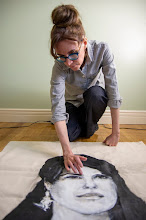Wednesday, June 17, 2009
Performance anxiety
"A classmate of mine from art school would characterize Winterson’s encounter as ‘losing her artist’s virginity’. I have no such story to tell..."
I was outside my usual territory in the library—in the Ps downstairs instead of the Ns upstairs—when I discovered Jeanette Winterson’s Art Objects: Essays on Ecstasy and Effrontery (Vintage International, 1997). Uh-oh…vintage…yes, I realize that blogs are generally about what’s new. However, this book is too good to avoid blogging about it. Winterson’s writing is eloquent but punchy with re-readable passages like this one about art historian Robert Fry: “It was he who gave us the term ‘Post-Impressionist without realizing that the late Twentieth Century would soon be entirely fenced in with posts” (6). It’s an understatement to call it an ‘easy read’ as the words seem to leap off the page, but skip ahead and you are only cheating yourself.
While standing at the bus stop under the warmth of the sun, I became enraptured only one page in. I hopped on the #12, anxious to continue reading, but it was not meant to be. The rhythm of the words couldn’t compete with the incessant cussing of a loud passenger. Exhausted from being kept up by a street party the night before, I fought back tears of frustration. When I finally finished reading the book from the sanctuary of my apartment, it was in spite of the sound of firecrackers set off from the street below (in the afternoon no less) and a deafening security alarm on the rooftop. Welcome to New York.
Winterson comes at the artist’s creative process from the perspective of a seasoned writer, revealing common ground between artists and writers. She begins this book of short essays by recalling the development of her love affair with visual art: it was in Amsterdam, and she was literally moved to tears even though she had no prior interest in art. A classmate of mine from art school would characterize Winterson’s encounter as ‘losing her artist’s virginity’. I have no such story to tell, although apparently sleepless nights in the city that never sleeps will practically reduce me to tears. I have never been affected by art in a visibly emotional way (as many of my classmates have), but once I came close. I sat in the National Gallery of Canada, in the presence of Janet Cardiff and George Bures Miller’s Forty Part Motet, a stunning audio installation of individual voices in a choir, willing the tears to come. In light of Winterson’s comment, “Art coaxes out of us emotions we normally do not feel…art works to enlarge emotional possibility” (108), I wonder, is something fundamentally wrong with me as a viewer? (Like Winterson, I have visited galleries in Amsterdam, but with dry eyes). Moreover, is there a right way to respond to art?
As an artist, there are certainly reactions that I prefer above others. While I was installing an exhibition a few years ago, someone called my cocoon sculptures adorable and someone else said they were hilarious. I was perplexed, since I had been striving for angsty, not funny or cutesy. One of Winterson's many comments that resonated with me is her suggestion that true artists are interested in the problem, not the solution. Now my mind is spinning. Is trying to control the viewer’s reaction effectively forcing a solution? Does advocating for change (say, of gender stereotypes) smack of effrontery? Considering that she is a pro at bringing questions out of readers, and that she is upfront about her aim to avoid arrogance as a writer analyzing art, Winterson really is an artist who puts problems before solutions.
SOURCES:
Winterson, Jeanette. Art Objects: Essays on Ecstasy and Effrontery. New York: Vintage International, 1997. Print.
Subscribe to:
Post Comments (Atom)


I love this post for reasons that you may not have intended, seeing ask your take on NYC and your neighborhood are not necessarily all that positive. There you were, deep in the book, trying to absorb the words and failing at points because the city insists on getting in your face. In your description the city seemed to strike me as a kind of non-stop performance art (in NYC style of course-the party, your exhaustion, the fire crackers, the swearing, the alarm . . . and then your reaction to that 'art'. Not all art appeals to everyone and everyone has a different reaction. -oelibrarian
ReplyDelete